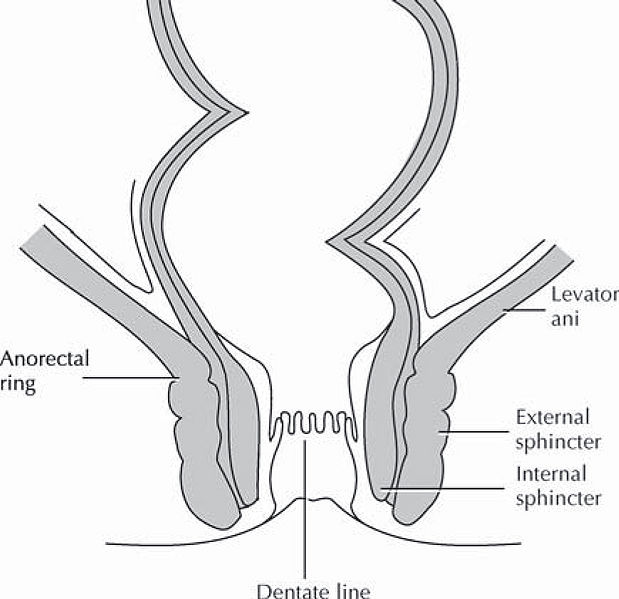Anal fissure pathophysiology
|
Anal fissure Microchapters |
|
Diagnosis |
|---|
|
Treatment |
|
Case Studies |
|
Anal fissure pathophysiology On the Web |
|
American Roentgen Ray Society Images of Anal fissure pathophysiology |
|
Risk calculators and risk factors for Anal fissure pathophysiology |
Editor-In-Chief: C. Michael Gibson, M.S., M.D. [1];Associate Editor(s)-in-Chief: Amandeep Singh M.D.[2]
Overview
The exact pathogenesis of anal fissure is not fully understood but constipation or anal trauma was supposed to instigate the fissure. It is understood that anal fissure is the result of either anal trauma (by constipation/diarrhea), perfusion defects with ischemia caused due to increased anal pressures and decreased blood flow or increased anal sphincter tone. In 90% of the patients, anal fissures are found in posterior midline. A small tear is seen that extends from dentate line to anal verge due to ischemia/poor perfusion of the area by inferior rectal artery (during increased sphincter tone).
Pathophysiology

An anal fissure is a linear tear or superficial ulcer of the anal canal, extending from just below the dentate line to the anal margin.
Pathogenesis
- Although constipation or anal trauma was supposed to instigate the fissure,the exact pathogenesis of anal fissure is not fully understood.[2]
- It is understood that anal fissure is the result of either anal trauma (by hard stools/diarrhea), perfusion defects with ischemia caused due to increased anal pressures and decreased blood flow or increased anal sphincter tone.
- In 90% of the patients, anal fissures are found in posterior midline. A small tear is seen that extends from dentate line to anal verge.[3]
- This is believed due to ischemia/poor perfusion of the area by inferior rectal artery (during increased sphincter tone).[4][5][6][7]
- Some studies in 1970-80 have suggested the increased tone of intenal sphincter as the basis of anal fissure genesis.[8][9][10]
- The increased internal sphincter tone also leads to decreased perfusion.[2]
- Use of anal manometry have suggested hypertonia of internal sphincter as a cause of anal fissure, and also relaxation in chronic anal fissures.[11][12]
Associated Conditions
- Crohn's disease
- Syphilis
- HIV/AIDS
- Previous anal surgery
- Anal cancer
- Tuberculosis
Microscopic Pathology
- On microscopic histopathological analysis, the following are characteristic findings of anal fissure:
- Presence of fibrosis at the base of the fissure when compared to normal internal anal sphincter.[13]
References
- ↑ Source=http://www.surgwiki.com/wiki/File:Ch31-fig1.jpg
- ↑ 2.0 2.1 Zaghiyan KN, Fleshner P (2011). "Anal fissure". Clin Colon Rectal Surg. 24 (1): 22–30. doi:10.1055/s-0031-1272820. PMC 3140330. PMID 22379402.
- ↑ Davies, Danielle; Bailey, Justin (2017). "Diagnosis and Management of Anorectal Disorders in the Primary Care Setting". Primary Care: Clinics in Office Practice. 44 (4): 709–720. doi:10.1016/j.pop.2017.07.012. ISSN 0095-4543.
- ↑ Klosterhalfen B, Vogel P, Rixen H, Mittermayer C (1989). "Topography of the inferior rectal artery: a possible cause of chronic, primary anal fissure". Dis. Colon Rectum. 32 (1): 43–52. PMID 2910660.
- ↑ Schouten WR, Briel JW, Auwerda JJ, De Graaf EJ (1996). "Ischaemic nature of anal fissure". Br J Surg. 83 (1): 63–5. PMID 8653368.
- ↑ Wray, D; Ijaz, S; Lidder, S (2008). "Anal fissure: a review". British Journal of Hospital Medicine. 69 (8): 455–458. doi:10.12968/hmed.2008.69.8.30742. ISSN 1750-8460.
- ↑ https://www.scopus.com/record/display.uri?eid=2-s2.0-84902519715&origin=inward&txGid=bc936e1b0b6831da3edcca60b04ca14a
- ↑ Nothmann BJ, Schuster MM (1974). "Internal anal sphincter derangement with anal fissures". Gastroenterology. 67 (2): 216–20. PMID 4847701.
- ↑ Hancock BD (1977). "The internal sphincter and anal fissure". Br J Surg. 64 (2): 92–5. PMID 890253.
- ↑ Gibbons CP, Read NW (1986). "Anal hypertonia in fissures: cause or effect?". Br J Surg. 73 (6): 443–5. PMID 3719268.
- ↑ Schouten WR, Briel JW, Auwerda JJ (1994). "Relationship between anal pressure and anodermal blood flow. The vascular pathogenesis of anal fissures". Dis Colon Rectum. 37 (7): 664–9. PMID 8026232.
- ↑ Farouk R, Duthie GS, MacGregor AB, Bartolo DC (1994). "Sustained internal sphincter hypertonia in patients with chronic anal fissure". Dis Colon Rectum. 37 (5): 424–9. PMID 8181401.
- ↑ Brown AC, Sumfest JM, Rozwadowski JV (1989). "Histopathology of the internal anal sphincter in chronic anal fissure". Dis. Colon Rectum. 32 (8): 680–3. PMID 2752854.